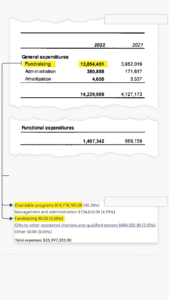An Investigative Journalism Bureau (IJB) investigation, published December 15, has revealed questionable practices – and regulatory lapses – in Canada’s health charity community, raising questions about fundraising practices, administrative costs and government oversight. It also demonstrates that the generosity of Canadians can be exploited.
According to the investigation, Breast Cancer Canada (BCC), whose annual revenue was $18.8 million in 2021/2022, spent $13.9 million on bankrolling its own fundraising. This is in conflict with their public disclosures that state $16 million was spent on ‘charitable activities.’
Trust is paramount to a charity, as it is to a healthcare provider or hospital network. Donors give to organizations they trust. But equally as important is knowing that your dollars are spent responsibly to drive impact. In addition to stories of the real-life benefits charities bring about, hard numbers matter to donors. I know this from having spent nine years on the board of a Canadian health charity, where our focus was firmly on our charitable objectives.
“Breast Cancer Canada spent $13.9 million on bankrolling its own fundraising.”
Canadians also rely on health charities. Whether they spend over $100 million a year, as the Canadian Cancer Society has in 2024, or just a few thousand, Canada’s health charities fund critical research, health infrastructure and patient services. They also lobby governments, advocate to influence policy, and educate the public. This has never been more important, as we collectively experience the collapse of our single-payer health system and face a tidal wave of mistrust in scientific endeavors.
The charitable sector in Canada benefits incredibly from tax breaks not available to for-profit and many non-profit companies. So do individuals, who receive tax benefits when they make charitable donations. Given that Canadians donated $11.4 billion to charity last year, the stakes for charities, individuals, and government coffers are high. With over 86,000 registered charities in Canada, the Canada Revenue Agency (CRA) has its work cut out to maintain the integrity of the system.
Tax incentives for both running and giving to a charity are so compelling that dishonesty is inevitable. Independent watchdogs like Charity Watch and Charity Intelligence rate charities on key metrics, and a 2020 survey found that as many as 60 per cent of Canadians are doing their own homework before blindly giving away their money. While neither watchdogs nor google searches paint the complete picture of the good a charity does, it’s clear Canadians aren’t always willing to take charities at their word, and distrust may be part of why Canadians are donating less now than before the pandemic.
Charity Intelligence gave BCC a one-star rating, describing “persistently high fundraising costs leading to overhead spending outside of Charity Intelligence’s reasonable range. In F2023, fundraising costs were 69% of donations.” But despite the watchdog’s abysmal rating, Canadians still gave 17.2 million dollars to the charity in 2023.
“Some charities blur the line between administrative and charitable expenses.”
Common metrics are used to describe how well a charity functions financially. The Fundraising Efficiency Ratio describes how much is brought in compared to how much is spent on fundraising. (If you spend a dollar to raise a dollar, your ratio would be 1, and you would have no money left to do good in the world.) The CRA guidance to keep fundraising expenses below 35 per cent is often cited as a benchmark to strive for, but many charities grossly exceed this by hiring fundraisers – as BCC did – or spending on lavish campaigns. But the opposite exists too – some charities, like Against Malaria Foundation Canada (AMFC), spend hardly any money to raise money thanks to a strong network of volunteers who work for free. (AMFC actually reports near-zero administration and fundraising costs, which also has raised the eyebrows of Charity Intelligence).
Another metric used is cents of every dollar spent on charitable mission. In 2024, the Terry Fox Foundation spent 74 cents of each dollar it raised on cancer grants and programs, compared to 9 cents per dollar on administration and 16 cents per dollar on fundraising according to Charity Intelligence, which gave the charity an A rating. But as the IJB – a non-profit newsroom at U of T’s Dalla Lana School of Public Health – reported, some charities blur the line between administrative and charitable expenses.
BCC, for example, was misleading when they claimed their street-level fundraisers, working on commissions as high as 60 per cent, were conducting public education while eliciting donations – a tactic rejected by the CRA. Former fundraisers told investigators they often lied about breast cancer treatments that don’t exist rather than educating prospective donors. Regardless, striking up a chat on a street corner to elicit a donation is not education in the CRA’s eyes.

SOURCE: BCC FINANCIAL STATEMENTS, CRA CREDIT: TORONTO STAR GRAPHIC
It’s clear that more stringent rules – and enforcement – are required to ensure charities are playing by the same rules. It’s not fair when prospective donors judge an honest charity more harshly just because they didn’t fudge their spreadsheets.
To be sure, it costs money to operate a charity. Having the right leadership team, call centre ambassadors, fundraisers and back-end support staff are essential to the long term success of a charity, just as for-profit businesses require talented people to drive them forward.
At the end of the day, charities are meant to spend their donations on driving impact that improves people lives, not lining the pockets of their associates. To maintain the trust of their donors – and of all Canadians – charities must fully commit to transparent financial records and strive to ensure each precious donated dollar is spent on creating a better world.


The comments section is closed.
This is a very interesting article. I learned a lot about the importance of transparency in health charities.